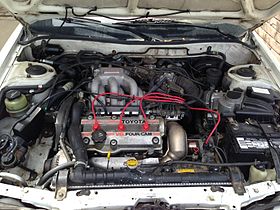This article needs additional citations for verification. (June 2024) |
| Toyota VZ engine | |
|---|---|
 2VZ-FE engine in a 1989 Toyota Camry DX | |
| Overview | |
| Manufacturer | Toyota Motor Corporation |
| Production | 1988–2004 |
| Layout | |
| Configuration | 60° V6 |
| Displacement | 2.0–3.4 L (1,992–3,378 cc) |
| Cylinder block material | Cast iron |
| Cylinder head material | Aluminium |
| Valvetrain | SOHC 2 valves x cyl. DOHC 4 valves x cyl. |
| Compression ratio | 9.0:1-9.6:1 |
| Combustion | |
| Fuel system | EFI Multi-port fuel injection |
| Fuel type | Gasoline |
| Cooling system | Water-cooled |
| Output | |
| Power output | 136–190 hp (101–142 kW; 138–193 PS) |
| Torque output | 159–220 lb⋅ft (216–298 N⋅m) |
| Chronology | |
| Predecessor | Toyota G engine (Straight-six) |
| Successor | Toyota MZ engine Toyota GR engine |
The Toyota VZ engine family is a series of V6 gasoline piston engines ranging from 2.0 to 3.4 L (1,992 to 3,378 cc) in displacement and both SOHC and DOHC configurations.[1] It was Toyota's first V6 engine, being made as a response to Nissan’s VG engine, one of Japan's first mass-produced V6 engines.
The VZ family uses a 60° V-angle design, and introduced many changes for Toyota, including various EFI, ECU, and engine improvements from generation to generation. The low angle DOHC and SOHC cylinder heads excel in low-mid torque and power, making the VZ series well-suited for various uses in cars, trucks, and SUVs.
The blocks are all strongly made using cast iron with large interconnected main bearing cradles and two bolt main bearing caps. Cylinder heads are made from aluminium. Forged steel crankshafts, and cast iron main bearing support girdles became standard with the 3VZ-FE. Piston and ring construction are typical parts, with rods varying between large and very large for stock V6 production engines.
- ^ "Toyota Scepter". 75 years of Toyota. Toyota Motor Corporation. Retrieved 31 May 2024.